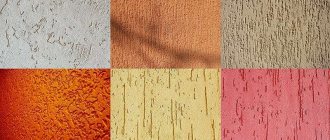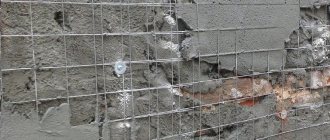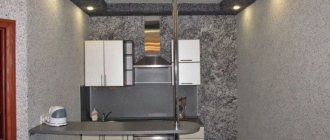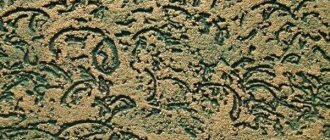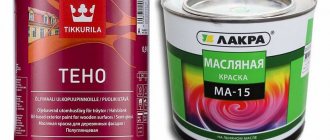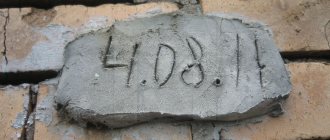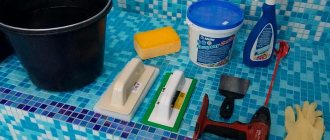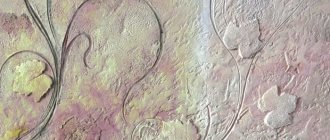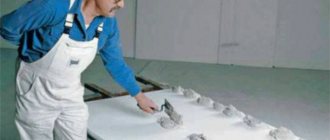Features of the plaster composition "Bark beetle"
This finishing façade material got its name because a correctly applied layer of cladding resembles the structure of wood that has been damaged by bark beetles. This effect occurs due to the presence of marble chips in the mixture. It is this that, when grouting, causes small pits and grooves to appear on the surface, which look like wood eaten away by wood beetle larvae.
On a note! When producing mixtures, marble grains are used, the size of which can range from 0.8 to 3.5 mm. Therefore, it is possible to obtain small or large grooves on the surface during plastering. The thickness of the finishing layer also depends on the size of the natural stone chips.
Application of bark beetle with a fine pattern Source deladom.ru
Plaster mortars are used for exterior finishing of houses in various styles. One of such proven and already classic mixtures is bark beetle. Finishing with an interesting texture hides many surface imperfections, including small irregularities.
Manufacturers produce the following façade finishing mixtures based on:
- Cement to which quartz chips have been added. This species can withstand freezing temperatures and weather conditions.
- Potassium, from which silicate-silicone resistant protective solutions are made. They are liquid glass.
- Acrylic, which allows you to create water-repellent mixtures.
- Silicone resin from which plasters are made for use in high humidity conditions.
Bark beetle plaster can have a finished appearance or a dry state. The first version of the material is a composition based on acrylic or silicone, and the second is a cement mixture.
The finished plaster composition is a paste. It is packaged in plastic buckets. This mixture is characterized by increased plasticity. It can be painted by the manufacturer at the factory.
Ready-made protective and finishing plaster solution Source bestofpartners.com
Dry plaster is initially usually produced in white or gray color. To obtain the required shade, the dried cladding is painted or pigment is added directly to the solution. Cement-based compositions are packaged in bags. Dry mixtures are diluted with water before the finishing process.
These plastering compounds are used for protection and neat cladding. Using mixtures, they give the walls an original appearance. Before applying bark beetle to the facade, you should definitely know that it is often used for cladding surfaces made of concrete, sandwich panels, bricks, and even those finished with insulation with a solid structure, such as polystyrene foam. The work is carried out without a respirator, since the process does not pose a health hazard.
The advantages of this type of plaster also include:
- a high degree of strength and environmental friendliness, because the plaster material is produced exclusively from natural raw materials and using modern technology;
- light weight, which does not create a large load on the structural elements of the house;
- resistance to sunlight, water, low temperatures and mold.
A dried bark beetle is not afraid of exposure to direct rays of the sun Source folksland.net
The service life of such protective decor is approximately 17 years. It is pleasant to the touch and does not burn. After drying, no cracks appear on it. In addition, the material has good adhesion.
The disadvantages of bark beetle include the difficulty of execution, since to apply it you need to know the technology and have experience. At the same time, only specialists using special tools can finish architectural elements with curved surfaces. The downside is also the need to use a tint to get the desired color. Usually the ideal shade is selected using computer technology.
Features of use in interior and exterior decoration
In each case, manufacturers endow building mixtures with different properties. On the street side, bark beetle textured plaster is under the aggressive influence of many factors. In summer, the finishing of the house is constantly under the scorching heat of the sun, which is replaced by torrential torrential torrents, sometimes along with hail. During winter seasons, temperatures drop to -45°C or -50°C. The coating must withstand all impacts for a long time.
Indoor conditions are not as harsh as outside. This is where the differences between the two types of plasters lie. Typically, for processing facades, a mixture of fractions of 3 mm or more is used, while for interior work the maximum grain size is up to 2 mm. There is also an intermediate variety - universal plaster.
Fraction size affects material consumption
Color palette
When finishing facades, bark beetles of different colors are often used. This allows you to decorate your home in an original way, making it stand out from other similar buildings. Thanks to its excellent paintability, it is possible to precisely select the warm or cool shade of the plaster.
The color of the protective decor is selected depending on the architectural style of the building, the design of the private area and the personal preferences of the homeowner.
Varied color palette of the bark beetle Source kraski-net.ru
On a note! Dirt from the walls is removed by annual washing. After all, it always hits structures with rain or even wind.
It is easier to color a dry mixture, because the process is carried out at the mixing stage by adding the required amount of dye. Ready-made compounds are more difficult to color. The best option is to contact specialists. Often such services are provided by stores that sell this type of plaster.
Preliminary tinting can be omitted if you use enamels made on the same basis as the facing mixture. They are used to paint dried plaster.
More often, modern facades have a warm shade. Many homeowners choose beige, brown, yellow and red colors for decor.
On a note! Before making a bark beetle on the facade, experts recommend paying attention to one of the interesting solutions. This is decorating a house in an antique style. For this design, dark plaster with stone chips is used. In this case, the material is applied with the most similar texture. Additionally, the base is finished with stone and architectural elements made of forged metal are installed.
House with a dark plastered facade Source pinimg.com
Preparatory process.
If you want plaster that retains its original appearance for a long time, you need to know how to make bark beetle plaster with your own hands and at the same time with high quality. First you need to diligently prepare the base by cleaning it and plastering it as follows. The process goes like this:
- First, all possible remnants of the previous coating are removed, cleaned of dirt and grease stains. If necessary, the wall is leveled using sand-cement raw materials.
- If bark beetle plaster is applied in a place where the moisture level is constantly elevated, then the wall is treated with a specialized antifungal solution.
- Any gaps are cut out and treated with gypsum putty.
- If you apply bark beetle plaster indoors with your own hands, know that the minimum thickness should be 2 cm, after which grouting is carried out. When application is carried out on external coverings or walls that are plastered with a mixture of lime and cement, no primer is needed. It is enough to thoroughly moisten the surface with plain water.
- The walls must be completely cleaned, degreased and leveled before application.
When all the above requirements are met, you can prepare a decorative solution.
Nuances of selecting “Bark beetle”
Bark beetle plaster is selected for the base that needs to be protected and decorated. This is the main criterion for choosing such a material for cladding facades.
If concrete walls are being finished, a cement or cement-lime mixture is used. In this case, any type of plaster mortar can be used for bricks. Additionally, with these types of compositions, mesh is often used for reinforcement. It is needed to increase the adhesion of the decorative protective layer.
Wooden surfaces are faced with compositions based on gypsum and limestone. Clay is often used as a plasticizer. At the same time, they strictly monitor its quantity. A large volume of clay in the solution leads to the appearance of cracks on the dried surface. When using a composition of gypsum and limestone, a reinforcing mesh is also additionally used.
Foam blocks have little adhesion. Therefore, their finishing is more difficult. To increase adhesion, a special mesh is first fixed to the base, and only then lining is performed using compounds with reinforcing components.
Decorating a house made of foam blocks with bark beetle Source remontnik.ru
See also: Catalog of companies that specialize in finishing materials and related work
What tools may be needed.
For any construction manipulations, you must have specialized tools, the list of which is given below:
- Bucket, plastic grater, sprayer.
- Drill equipped with a mixer attachment.
- A spatula or construction spatula for applying raw materials.
- A roller and a container under it to apply the primer liquid.
In order for the bark beetle plaster to lay down easily, you definitely need to stock up on similar construction attributes. For visual completeness and aesthetics, do-it-yourself bark beetle plaster is leveled with a spatula.
Technology of finishing works with bark beetle plaster
The protective and finishing process of facade surfaces is always carried out in stages. This allows you to strictly follow the work technology and carry out the cladding without errors. Therefore, specialists almost always complete the finishing efficiently the first time.
Preparation
Before applying bark beetle to the facade wall, prepare the base. Remove dirt, grease and old finishes. If there are cracks, they are eliminated with a cement mixture. Large defects are first expanded. This is usually done using a grinder. Only then are the defects sealed with a solution. After the repair mixture has dried, the surfaces are coated with compounds that prevent the appearance of fungus.
The adhesion of walls on the outside of the house is improved by applying a thick acrylic primer. This process is performed manually or mechanically. To speed up work, a spray gun is often used.
Mechanized method of applying primer Source twedo.ru
A thick primer composition corrects the absorbency of the walls. It also promotes more uniform drying of decorative and protective plaster. Primer is not always used on walls made of concrete and cement-lime materials. Such facades are often simply moistened with water. This operation is performed an hour before the start of plastering work.
Beacons are also prepared before plastering. These are profiles made of metal or plastic. They have holes for mounting. Using L or T-shaped beacon-limiters, a layer of protective and decorative plaster with a thickness of 3 to 10 mm is applied.
Preparing the mixture
When using dry plaster, it is mixed with water. The solution is prepared in parts, as it has the ability to dry quickly. Kneading is carried out according to the manufacturer's instructions. It is always placed on the packaging. During the preparation of the mixture, the temperature, proportions of the components and the following sequence are strictly observed:
- A container, for example a bucket or deep basin, is filled with water. It should be at room temperature.
When mixing plaster, first fill the bucket with water with a maximum temperature of 23°C Source infourok.ru
- The dry plaster composition is poured into water in small portions. Typically, an electric drill equipped with a mixer attachment is used for kneading. This allows you to stir the mixture faster and obtain a mass with a homogeneous structure. The kneading is carried out at low speed and with the nozzle completely immersed in the plaster composition so that air bubbles do not form in it. The process is continued until water disappears from the surface of the solution.
- The mixed mixture is left alone for about 5 minutes. During this time he insists. After this, the solution is thoroughly mixed once more. The result is a composition similar to thick sour cream.
The mass should not be too thick, because it is inconvenient to apply. In addition, the consumption of such a composition increases. If the solution is prepared very liquid, then it will drain. Therefore, it will not be possible to create a textured pattern.
If you want to use a mixture of a certain color, then add a special dye. In this case, the solution is stirred very carefully so that after application it does not result in a surface with stains.
Tinting plaster mortar Source loisaidanest.com
Important! Manufacturers recommend tinting suspensions before using them, and covering dry mixtures with special paints on the façade after drying.
Common plastering methods
When deciding how to properly apply bark beetle to a façade, it is necessary to take into account the basis on which the work is being carried out. After all, the plastering technique depends on it. Craftsmen use manual and mechanized options for distributing plastic material.
Video description
An interesting method of installing metal limiting beacons is described in the following video:
Limiters can also be installed on a solution. More often they use a gypsum mixture, which takes less time to dry. It is also applied under the beacons approximately every 300 mm. The limiters are recessed flush into the solution.
Applying base plaster
First, the solution is applied using a wide spatula. The thickness of this layer should slightly exceed the depth of the beacons. Then they use a rule to level the surface.
Then the limiting beacons are removed. The operation is performed before the base layer of plaster hardens. Then the recesses from the beacons are sealed with the same solution.
Facade cladding “Bark beetle”
Before applying bark beetle to the exterior of the house, you need to study the cladding technology. The process is always performed on a previously prepared surface. Its quality affects the texture of the cladding pattern, which is characteristic of this finish.
The plaster composition is applied by professionals using a stainless steel spatula and a plastic trowel. During plastering, specialists also often use a trowel.
Using tools when plastering Source sandors.ru
Typically, cladding begins from the bottom of the wall. The mixture is applied in small portions onto a spatula. Then it is evenly stretched over the surface. The thickness of the layer is created no less than the size of the marble grain, and the tool is held at an angle of 60° relative to the base being tiled. The plaster composition is distributed in a horizontal or vertical direction.
Video description
The intricacies of plastering a large area by one person are shown in the following video:
Usually large areas are plastered at one time by a team of professionals. Work is carried out when the façade is not exposed to sunlight. The ideal option is calm, dry weather. After all, this type of plaster has the ability to dry quickly. This process accelerates in the sun and wind.
The pattern on the finished surface is formed when the layer dries a little and the material stops sticking to your hands. In other words, experts apply the plaster solution and wait approximately 20 to 40 minutes. The pattern is created with a plastic trowel. It is moved in different directions:
- from top to bottom – you get the “rain” texture;
- circular movements - form a “lamb”;
- from the left corner of the upper part of the wall to the lower right - create a “diagonal rain”;
- alternating movements in the vertical and horizontal directions form a “carpet”.
Forming a plaster pattern Source myshtukaturka.ru
When the layer of applied material dries quickly, it is sprayed with water. This action allows you to get a little extra time to create a textured ornament.
Mechanized plastering option
Before applying bark beetle to the facade of a house, you also need to become familiar with the pros and cons of the mechanized method of plastering walls on the street side. After all, this finishing option is often used by professionals when performing large volumes of cladding.
Specialists use a special automated device in their work. Its nozzle is close and perpendicular to the facade. The machine drops the finished mixture under pressure. The operator distributes it evenly over the surface.
Mechanized plastering Source tildacdn.com
Using a mechanized cladding method:
- The minimum thickness of the plaster layer is obtained. This reduces the consumption of facing material.
- They ensure uniform application of the plaster mortar, its excellent adhesion to the surface and better strength of the finishing layer.
- They create a continuous supply of the mixture over the entire area of the facade, which helps prevent the appearance of joining seams.
- Eliminates the appearance of air bubbles, foreign inclusions and dry lumps.
After mechanized plastering, the surface is leveled manually. Often, a special grinding machine equipped with a fleecy working surface is additionally used. It is used to create a textured ornament.
Mechanized grinding Source mehshtuk.ucoz.ru
Plastering on insulation material
The bark beetle is often applied to foam plastic. When carrying out the work, an adhesive composition, reinforcing mesh and primer are additionally used. These materials are necessary so that the plaster does not crumble or deform.
First, a fiberglass mesh is fixed to the insulation using glue. The adhesive will gain strength only after 3 days. Therefore, further work is carried out after reliable fixation of the reinforcing mesh.
Important! The process of applying plaster to insulation begins with priming the surface and subsequently is no different from standard similar work. It is only necessary to protect the walls from the sun and precipitation for 2 days.
Conventional diagram of applying bark beetle to insulation Source baumax.kh.ua
Areas of use
Bark beetle plaster was originally used to decorate the external walls of buildings. But designers have successfully found use for it in the interior.
Plasticity and obedience to the master’s tool are distinctive features that make it possible to apply plaster on a base of varying complexity and any type - concrete, cement, brick, wood, plasterboard, glass and many others.
Indoors, Bark Beetle plaster is more often used in the interior of bathrooms and toilets, due to its ability to retain its structure for a long time and its properties in a humid environment.
When choosing plaster, it is advisable to take into account the dominant component in the composition. For example, a water-based, odorless material is suitable for residential premises.
Painting a plastered facade
The finished dried plaster surface is painted using acrylic or silicone paint. Acrylic-based dyes are used only two weeks after using the bark beetle. Silicone paints can be used three days after the façade is plastered.
Often the dyeing process is carried out in two stages. First, paint the entire surface. During work, grooves and other recesses are carefully painted over. At the second stage, the same paint is applied, but in a darker or lighter shade. It is used to paint only the upper part of the plaster, without affecting the grooves and pits.
Experts also use acrylic varnish to paint bark beetles. Manufacturers add coloring pigments or mother-of-pearl to this material. It is applied evenly over the surface. The work is carried out with a steel spatula.
Painting a plastered facade Source inves-stroy.ru
Briefly about the main thing
Protective and decorative plaster composition bark beetle is used for cladding facades, because the material is resistant to sunlight, moisture, and low temperatures. It is durable and lightweight. However, the cladding is carried out exclusively strictly according to technology and often it has to be coated with paint after application or tinted during the preparation process.
The plaster solution is applied to the surface, which is previously prepared and can be built from various materials, including concrete, brick and even wood. The coating layer is no less than the size of the grain used in the mixture. A textured ornament is created by moving the grater in a horizontal, vertical, diagonal direction or in a circle.
Ratings 0
Technology for applying the mixture and do-it-yourself reinforcement
When applying a decorative coating to a layer of foam plastic or other external insulation, intermediate coating technology . It includes preliminary application of a layer of tile adhesive on the surface of the insulation, installation of a mounting mesh - reinforcement, leveling the preparatory layer with another adhesive layer.
After this, the preparatory layer is primed. When reinforcing, the mesh is not simply installed on top of the adhesive layer, it is pressed into it to achieve complete and durable contact . The second layer should completely hide it inside itself.
Reinforcement
Trying on the mesh
The preparation surface must be smooth and neat, since the final appearance of the wall largely depends on this. To do this, it is best to apply the adhesive layer with a notched trowel ; it evenly distributes the adhesive over the surface, leaving calibrated stripes, which are subsequently crushed by a mesh and covered with a second layer of adhesive.

